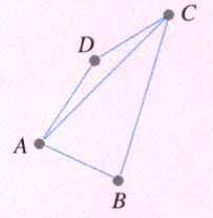Find the area of ΔABC, if a=6m and ∠Band ∠C are respectively 30∘ and 90∘.
To find the area of triangle ABC where side a=6 m, ∠B=30∘, and ∠C=90∘, we can follow these steps:
Step 1: Identify the triangle type
Since ∠C=90∘, triangle ABC is a right-angled triangle with C as the right angle.
Step 2: Use the properties of the triangle
In a right triangle, we can use the definitions of trigonometric functions to find the lengths of the other sides. We know:
- Side a is opposite to angle A.
- Side b is opposite to angle B.
- Side c is the hypotenuse.
Step 3: Find the length of side b (adjacent to angle B)
Using the tangent function for angle B:
tan(B)=oppositeadjacent=ACBC
Since ∠B=30∘:
tan(30∘)=ACBC=1√3
Step 4: Find the length of side AC
We can express AC in terms of BC:
AC=BC⋅tan(30∘)=BC⋅1√3
Step 5: Use the sine function to find side b
Using the sine function for angle B:
sin(B)=oppositehypotenuse=ACAB
Since AB=a=6 m:
sin(30∘)=AC6
We know sin(30∘)=12:
12=AC6
Thus,
AC=6⋅12=3 m
Step 6: Find the length of side BC
Now, we can find BC using the Pythagorean theorem:
AB2=AC2+BC2
Substituting the known values:
62=32+BC2
36=9+BC2
BC2=36−9=27
BC=√27=3√3 m
Step 7: Calculate the area of triangle ABC
The area A of triangle ABC can be calculated using the formula:
A=12×base×height
Here, we can take BC as the base and AC as the height:
A=12×BC×AC
Substituting the values:
A=12×(3√3)×3
A=12×9√3=9√32 m2
Final Answer
The area of triangle ABC is 9√32 m2.
---
Since ∠C=90∘, triangle ABC is a right-angled triangle with C as the right angle.
In a right triangle, we can use the definitions of trigonometric functions to find the lengths of the other sides. We know:
- Side a is opposite to angle A.
- Side b is opposite to angle B.
- Side c is the hypotenuse.
Using the tangent function for angle B:
tan(B)=oppositeadjacent=ACBC
Since ∠B=30∘:
tan(30∘)=ACBC=1√3
We can express AC in terms of BC:
AC=BC⋅tan(30∘)=BC⋅1√3
Using the sine function for angle B:
sin(B)=oppositehypotenuse=ACAB
Since AB=a=6 m:
sin(30∘)=AC6
We know sin(30∘)=12:
12=AC6
Thus,
AC=6⋅12=3 m
Now, we can find BC using the Pythagorean theorem:
AB2=AC2+BC2
Substituting the known values:
62=32+BC2
36=9+BC2
BC2=36−9=27
BC=√27=3√3 m
The area A of triangle ABC can be calculated using the formula:
A=12×base×height
Here, we can take BC as the base and AC as the height:
A=12×BC×AC
Substituting the values:
A=12×(3√3)×3
A=12×9√3=9√32 m2
The area of triangle ABC is 9√32 m2.
Topper's Solved these Questions
- BOOK - NAGEEN PRAKASHAN ENGLISHCHAPTER - TRIGNOMETRIC FUNCTIONSEXERCISE - EXERCISES 3A12videos
TRIGNOMETRIC FUNCTIONS
- BOOK - NAGEEN PRAKASHAN ENGLISHCHAPTER - TRIGNOMETRIC FUNCTIONSEXERCISE - EXERCISES 3B24videos
TRIGNOMETRIC FUNCTIONS
- BOOK - NAGEEN PRAKASHAN ENGLISHCHAPTER - STRAIGHT LINESEXERCISE - Exercise207videos
STRAIGHT LINES
Similar Questions
Find the area of ΔABC, if a=10cm, ∠B=45∘ and ∠C=45∘
View SolutionFind the area of ΔABC, if a=10cm, ∠B=45∘ and ∠C=45∘
View SolutionFind the area of ΔABC if : a=6,b=8,C=300
View SolutionFind the area of ΔABC if : a=18,b=24,C=30
View SolutionFind the area of ΔABC, if a=10, b=7√2m and c=45∘
View SolutionIn ΔABC, a=4, b=6 and ∠B=30∘, evaluate sinA.
View SolutionFind ∠A+∠B+∠C+∠D
 View Solution
View SolutionFind the area of a ΔABC in which ∠A=300,b=6cm,c=2cm.
View SolutionIn ΔABC, a=16, b=12 and ∠B=30∘, find sinA.
View SolutionIn a ΔABC,∠A=2∠B=3∠C, find each of the triangle.
View Solution

